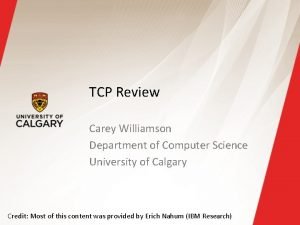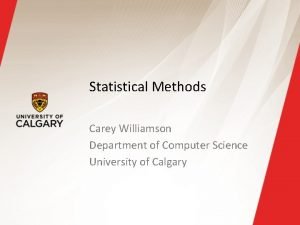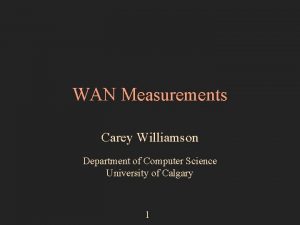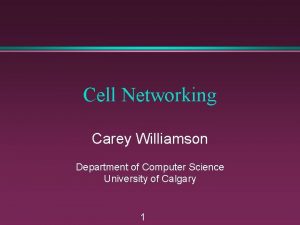Simulation Carey Williamson Department of Computer Science University







- Slides: 7

Simulation Carey Williamson Department of Computer Science University of Calgary

2 Outline § Plan: —Introduce basics of simulation modeling —Define terminology and methods used —Introduce simulation paradigms § Monte Carlo simulation § Time-driven simulation § Event-driven simulation —Technical issues for simulations § Random number generation § Statistical inference

3 Monte Carlo Simulation § Estimating an answer to some difficult problem using numerical approximation, based on random numbers § Examples: numerical integration, primality testing, WSN coverage, poker hands § Suited to stochastic problems in which probabilistic answers are acceptable § Might be one-sided answers (e. g. , prime) § Can bound probability to some epsilon § There is (usually) no notion of time at all

4 Time-Driven Simulation § § Time advances in fixed size steps Time step = smallest unit in model Check each entity to see if state changes Well-suited to continuous systems —e. g. , river flow, factory floor automation § Granularity issue: —Too small: slow execution for model —Too large: miss important state changes

5 Event-Driven Simulation (1 of 2) § Discrete-event simulation (DES) § System is modeled as a set of entities that affect each other via events (messages) § Each entity can have a set of states § Events happen at specific points in time (continuous or discrete), and trigger state changes in the system § Very general technique, well-suited to modeling discrete systems (e. g, queues)

6 Event-Driven Simulation (2 of 2) § Typical implementation involves an event list, ordered by time § Process events in (non-decreasing) timestamp order, with seed event at t=0 § Each event can trigger 0 or more events —Zero: “dead end” event —One: “sustaining” event —More than one: “triggering” event § Simulation ends when event list is null, or desired time duration has elapsed

7 Summary § Simulation methods offer a range of generalpurpose approaches for performance eval § Simulation modeler must determine the appropriate aspects of system to model § “The hardest part about simulation is deciding what not to model. ” - M. Lavigne § Many technical issues: RNG, validation, statistical inference, efficiency § We will look at some examples soon













